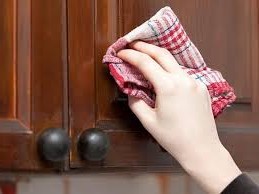HOW TO KEEP YOUR KITCHEN FREE OF GREASE
October 30, 2013 by admin
Filed under Cleaning Procedures and Measures for Controlling Pests
 Cleaning the kitchen and working platform is vital to ensure that your family is protected from contaminated food. A dirty kitchen and platform could lead to contamination of food that is to be consumed, further leading to an illness or ailment of the digestive system.
Cleaning the kitchen and working platform is vital to ensure that your family is protected from contaminated food. A dirty kitchen and platform could lead to contamination of food that is to be consumed, further leading to an illness or ailment of the digestive system.
Indian cooking involves usage of oil in almost every dish be it a curry, a chutney or a fry item. The chances of oil spread is very high. The oil and smoke circulates along with the air and settles down on all open surfaces.
Cleaning the oil spots from your kitchen cabinets is a quick and easy task if you know how to clean it. How does the oil settle on the kitchen surfaces which includes tiles, exhaust, cabinets etc. You will observe that oil splashes and spread all over the counter when we do seasoning for curries, deep fry eatables.
The oil vapors settles on the cupboards and cabinets. Dust in the air is attracted to this oil droplets and this becomes a layer. The vulnerable areas in the kitchen is the area behind the stove, the stove top exhaust , exhaust fan fixed on the wall. All tile surfaces get affected if not cleaned for some time.
The product you use should be capable of removing the stubborn grease on surfaces. You can clean kitchen cabinets made of wood with warm water diluted with liquid soap cleaner in a 1:2 ratio. Use a good scrubbing pad to dip in the solution and clean the surfaces.
Oil spread or spilled on clothes is another mis. Read this article HOW TO REMOVE STAINS FROM CLOTHES to understand the solutions
The inner surfaces of cabinet door handles will be very sticky and you need to use a small tool to dig the grimy oil collection. If the cabinet surfaces are colored wood, do a spot test and confirm prior to proceeding further.
However, if the oil stains, grease build-up high then opt for the natural way of cleaning, use vinegar. It is a natural cleaner and removes oil stains pretty easily.
- If you use vinegar then use a solution of half part vinegar and half part water if the stains are light.
- If the oil stains are stubborn, then you can use vinegar without using water. Pour undiluted vinegar into spray bottle and spray onto surface. Let it remain for 10 to 15 minutes. Wipe clean with dishcloth or non-abrasive scrubber.
- Lime and club soda can also be used to clean the oil spots and grease build-up from the kitchen cabinets.
- You can clean stove top exhaust hoods with baking soda. On a damp sponge add some baking soda and wipe the surface down. Immediately follow wiping of the surface with a clean cloth to remove any powder residue.
- Clean the kitchen platform by wiping with a cloth dipped in vinegar. The acidic content of the vinegar cleans and removes all grime that accumulates on the platform.
- Similarly, cleaning your stove with a cloth dipped in vinegar removes all spill stains and leaves your stove shining.
- Do not allow water to stagnate on the platform. Clean dry the stove and platform.
- Clean your stove and kitchen platform after cooking. This will remove all dirt, oil and will keep insects in the kitchen. If the platform is left uncleaned, lizards, ants and cockroaches will crawl all over the area.
- Watch out for the cupboards that are fixed on the wall. Check if the plaster on the wall facing the kitchen platform is intact. I’ve observed cracks in our neighbors home where thin layer of plaster keeps breaking and falling on the platform. This mainly occurs when the cabinets are opened to take out kitchen groceries.
To keep your kitchen neat and orderly spend 15 to 20 mins daily to organize and segregate. This will keep insects and chaos at bay.








